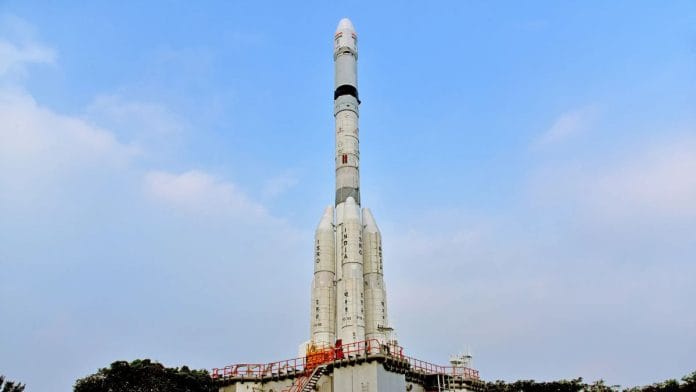New Delhi: On 30 December last year, when the Indian Space Research Organisation (ISRO) successfully launched the historic space docking experiment or SpaDeX, the then chairperson of the space agency, S Somanath, made another landmark announcement. The first ISRO launch of 2025 (NVS-02)—the second mission for India’s Navigation with Indian Constellation (NavIC) onboard the Geosynchronous Satellite Launch Vehicle (GSLV-F15)—has been touted by the space agency as its 100th launch.
But ISRO’s announcement on the centennial launch stirred a huge debate among space enthusiasts and even scientists, many of whom argued that the space organisation has left out many missions. Some argued that if ISRO was only taking into account orbital missions, the number would not reach hundred. Another group said it was over hundred, taking into account all its missions—suborbital, orbital, and test demonstrations.
However, ISRO clarified that it was only counting launches from Satish Dhawan Space Centre in Sriharikota, Andhra Pradesh.
ISRO will launch its 17th GSLV flight Wednesday (29 January). The GSLV will be equipped with an indigenous cryo stage—the rocket’s final stage (cryogenic stage) that was developed and manufactured indigenously. Incidentally, it is the eighth operational GSLV flight with an indigenous cryogenic stage.
ISRO’s GSLV launcher will place into orbit the second batch of NavIC satellites, which will bring India a step closer to having its very own GPS-styled navigation system.
Also Read: Search for an Indian Carl Sagan is on. Science influencers are being trained in labs and likes
All about GSLV-F15
The 29 January mission aims to deploy the second-generation navigation satellites with the NavIC system to enhance India’s regional navigation capabilities.
NavIC, which is India’s answer to GPS, is designed with a constellation of seven satellites and a network of ground stations operating 24×7.
It offers two services—Standard Position Service (SPS) for civilian users and Restricted Service (RS) for strategic users.
It is a standalone navigation satellite system, which is currently being used on a regional scale but will be developed in the coming years as a ‘Made-in-India’ global satellite navigation system which will be at par with US’s GPS, Europe’s Galileo or China’s BeiDou.
In 2023, the Indian government directed all mobile phone manufacturers to make all their phone models compatible with NavIC, starting January 2023.
Senior officials from the Department of Space told ThePrint that while this is not a strict deadline, they expect major mobile companies, including Samsung, Apple, and Xiaomi, to comply with the directives and accommodate NavIC in their hardware by 2025.
NavIC coverage includes India and a region up to 1500 kilometres beyond the Indian boundary. The first NavIC mission (NVS-01) was launched in May, 2023.
Is this the 100th ISRO launch?
The debate is still raging on social media and space forums. Many said SpaDeX was ISRO’s 95th launch, which implies that the 29 January launch will be the space agency’s 96th launch.
“In ISRO’s launch stream yesterday (December 30), it was officially said that PSLV-C60 is the 99th ISRO launch, and the next mission will be the 100th. In fact, C60 was ISRO’s 95th ‘orbital’ launch attempt and not the 99th,” a 31 December post on X by the handle Anshuman (TitaniumSV5) said.
?1/4
In ISRO's launch stream yesterday it was officially said that PSLV-C60 is the 99th ISRO launch and the next mission will be the 100th.
In fact C60 was ISRO's 95th 'orbital' launch attempt and not the 99th. @isro
Tally of all the orbital launch attempts by all LVs⬇️ pic.twitter.com/Ual9vqoqAB
— Anshuman (TitaniumSV5) (@TitaniumSV5) December 31, 2024
An orbital launch propels a spacecraft into Earth’s orbit, allowing it to circle the planet continuously. A sub-orbital launch, on the other hand, only reaches a certain height in space before falling back to Earth, meaning it does not complete a full orbit.
The X post, which has since garnered over 10,000 views, stirred an online argument highlighting that ISRO had left out dozens of sub-orbital and sounding rocket launches, or missions involving small, low-cost rockets that carry scientific instruments into suborbital space.
“I blame this on ISRO’s website admin for not properly maintaining the launch list. The erroneous inclusion of few sub-orbital launches and exclusion of few others has probably led to all this confusion of PSLV-C60 being the 99th launch,” the handle said in another post.
4/4
I blame this on ISRO's website admin for not properly maintaining the launch list – https://t.co/2ncet0aQqq
The erroneous inclusion of few sub orbital launches and exclusion of few others has probably led to all this confusion of PSLV-C60 being the 99th launch.
— Anshuman (TitaniumSV5) (@TitaniumSV5) December 31, 2024
But ISRO remains unmoved. A senior ISRO official told ThePrint that GSLV-F15 is, in fact, the 100th launch from the Sriharikota spaceport—including successes and failures. However, the official said, the confusion arose because this was not a count of the total missions the space agency had undertaken since its inception.
Missions, he said, would take into account all orbital, sub-orbital, sounding rocket, test demonstration, and private launches.
“There is a difference between launches and missions. When we say it is the 100th launch, we mean all launches that have happened from the Sriharikota Range (SHAR),” the official clarified.
(Edited by Radifah Kabir)
Also Read: UP village kids forced ISRO to bring space lab. Now they use drones, building weather station






